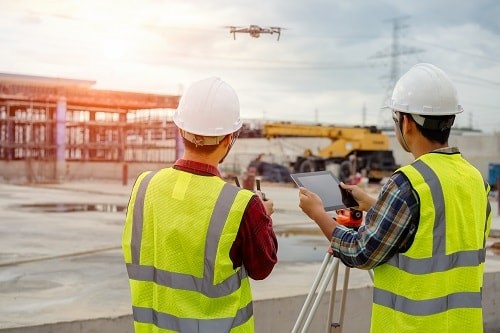Health and safety technologies are gaining popularity amongst environmental, health and safety (EHS) practitioners as firms begin to explore new initiatives to reduce serious injuries, fatalities and high-potential events.
Features
New tech for combating risks and Covid-19 in workplaces
In the wake of the Covid-19 pandemic, firms can also benefit from tailoring more extensive EHS solutions to combat the transmission of the virus. This article explores innovative technologies and approaches that help reduce situational and systemic risks in the workplace, as well as digital solutions that can be deployed to help mitigate the impact of Covid-19.
What technologies should health and safety managers invest in?
Serious injuries, fatalities and high-potential events vary for firms according to their different risk profiles. For instance, firms within high-risk industries like waste management face more fatalities via contact from moving machinery in comparison to firms in low-risk industries like retail, whose main source of risk is violence resulting in injury. Therefore, firms should ensure they tailor their investment and implementation approach appropriately.
Very high-risk and high-risk industries: these benefit from innovation and bespoke solutions. Firms within industries classified as very high-risk or high-risk will typically have easier access to budgets for innovative endeavours. As a result, they are better positioned to explore bespoke solutions to their EHS needs. However, these firms must ensure proper controls are already in place before further enhancing these controls with technology. For example, for lockout-tagout (LOTO) activities, proper work procedures must be in place already before leveraging any digital EHS service such as a mobile app to enhance the procedure. Likewise, during confined space entry, all necessary precautions should be taken and a proper rescue plan in place even before utilizing vital sign and environmental monitors. Firms that fall within this risk and budget category should prioritize large-scale rollout for multiple high-impact use cases across their operations.
Medium-risk industries: these benefit from cross-functional mature technologies. Firms within industries classified as medium-risk should focus on identifying mature technologies with cross-functional use cases. They should undertake pilot studies to address business-specific or site-specific EHS issues and ensure adequate ROI before full rollout of the technology. For instance, consumer goods manufacturing and logistics firms typically fall within this risk profile and may benefit from implementing fatigue monitoring and vital sign monitoring technology. More so, both types of wearable technologies can be applied to multiple use cases across a firm’s operations, demonstrating an opportunity for positive ROI.
Low-risk industries: these benefit from solutions for workspace awareness and security. Low-risk industries can include universities, retail establishments, banks, insurance, and real estate firms. However, they do face their own set of challenges. For instance, even in low-risk industries, lone worker activities, workplace violence and intentional negligence can introduce situational risks. And, very mature technologies like location tracking wearables, two-way communication radios and CCTV security solutions may already be industry standard. Even office environments within the banking industry may have ergonomic risks, which may introduce or accelerate fatigue. To summarize, firms within this risk category should focus on deploying very mature solutions with proven ROI and may even benefit from second or third mover advantage and economies of scale to facilitate future deployment opportunities.
Tech roadmap for EHS technologies
Verdantix developed the Tech Roadmap methodology to help senior managers successfully transform their operations and value propositions. The Verdantix Tech Roadmap analysis of EHS technologies below addresses the maturity, proven business value and pace of innovation of various EHS technologies, which will help EHS managers make critical investment decisions when comparing solutions that are available in the market.
 Cyberhawk, Golder and Ramboll offer drone services for confined space inspections
Cyberhawk, Golder and Ramboll offer drone services for confined space inspections
New technologies to enhance health and safety
Health and safety professionals can benefit immensely by leveraging data generated from EHS digital transformation to implement behavioural changes. There are several solutions that specifically address situational risks posed by worker interactions with machinery:
- Firms can use technology to substitute situational hazards resulting from high-risk activities such as confined space entry, inspections, working at height, and inspections in hazardous environments by replacing a human worker with a Cyberhawk, Golder and Ramboll offer drone services for confined space inspections, while firms like Airbus Aerial, DroneDeploy and TCS offer drone services for vertical inspections at height.
- Proximity sensing and geofencing can be used to highlight and reduce worker-machine interaction. Geofencing can be used to manage and secure access to identified sites and implement ‘machine cut-off’ or ‘switch-off’ commands during unsafe access, whereas analytics platforms can give visibility of worker-machine interactions. High-risk industries can consider vendors such as Acumentive, Guardhat, Industrial Scientific, Logical Safety and Triax Technologies which offer proximity sensing and geofencing solutions.
- Situational risks can also result from a lack of work process control or unfamiliarity with work processes, site rules and site layout. Permit-to-work and contractor management solutions can control and limit high-risk work activities to trained and experienced workers. Firms like Cognibox, SAI Global and SHE Software provide contractor management solutions, which ensure that proper training, induction and certification are carried out before contractors are allowed on site to work. Engage EHS, Simple But Needed (SBN) and Sphera also offer permit-to-work solutions enabling the control of high-risk work activities and ensuring documented oversight of risk.
Once firms have identified the systemic factors with the highest SIF potential, they can apply technology to enhance hazard controls.
To enhance these controls, EHS professionals can leverage the following technology solutions:
- Systemic risks with high SIF potential often arise from poor training, poor worker wellbeing and poor mental health. Poor worker training for new roles can lead to errors, incidents, injuries, and fatalities. Training solutions from vendors like Enablon, EtQ, Gensuite, Intelex and OneLook Systems can mitigate these risks. For worker wellbeing and health, vendors like Cority have gamified fit-for-duty questionnaires to be more engaging to employees. Solutions like these ensure that workers are in the right frame of mind to carry out tasks, thus reducing error rates linked to lack of focus.
- Firms can use wearable monitors to detect temperature stress and fatigue, which are sources of systemic risks during work processes. These tools can highlight and visualise high-risk areas, activities and work patterns. For instance, Caterpillar uses Fatigue Science’s wearable technology for its fatigue management system – consensually collecting employee sleep data and calculating an effectiveness score to create a fatigue risk profile while conforming to GDPR and allaying worker privacy concerns. Since heat and cold stress may also result in physical and cognitive loading and cause fatigue, firms like Kenzen and Equivital offer wearable solutions that can track heat stress and worker vital signs, respectively.
 Firms can use wearable monitors to detect temperature stress and fatigue
Firms can use wearable monitors to detect temperature stress and fatigue
- Historical data gathered from vital signs and fatigue monitors can be used to create risk profiles, and subsequently can serve as source material for machine learning algorithms, highlighting statistically significant areas of concern where accidents and incidents may occur. Firms such as Airsweb, Enablon and VelocityEHS leverage the power of AI and analytics to provide these insights.
Health monitoring tools in the fight against Covid
In addition to technologies that reduce serious injuries, fatalities and high potential events, EHS managers should also explore various IH and OH tools within EHS solutions to help respond to the current pandemic. In some cases, these solutions integrate IH and OH data, allowing firms to identify and address critical occupational health challenges and increase the likelihood of addressing similar issues in the future, thereby building business resiliency.
- Firms can deliver training remotely for employees who are working from home to meet training requirements. Vendors like HSI, Alcumus and Pro-Sapien can deliver training relevant to Covid-19 using these remotely accessible software solutions.
- Covid-19 pandemic has caused firms to reduce in-person interaction to curb new infections. In response, vendors such as Alcumus, a UK-based provider of technology-led compliance and risk management solutions, has begun delivering remote audit capabilities that allow firms to remotely inspect and exchange content electronically. Similarly, RealWear, through its augmented reality wearables and software solutions, allows remote virtual interaction between individuals. An example of this is remote healthcare proctoring, which reduces the delay in patient care and eliminates the need for onsite examination by clinicians in light of travel restrictions.
Key takeaway
We are in an exciting technological age, with Industry 4.0 in full effect and new technology entering the market almost daily. We suggest EHS professionals explore solutions and how
they correspond to their specific business needs. As today’s EHS role increasingly focuses on innovation, decision-makers need to make informed decisions about which technologies are worth their investments, whether now or in the future.
Bill Pennington is senior analyst, EHS at Verdantix
New approaches to high potential events: Report at: bit.ly/3eOI2Lk
FEATURES

Sedentary working and how to combat the ‘sitting disease’
By Gavin Bradley, Active Working on 05 April 2024
Prolonged and excessive sitting poses a major risk to our health, but the Get Britain Standing campaign and On Your Feet Britain Day on 25 April are a great way of encouraging workers to sit less and move more.

Company culture and wellbeing: a crucial link
By Bex Moorhouse, Invigorate Spaces on 05 April 2024
Investing in measures to support worker wellbeing will be ineffective unless the company culture genuinely incorporates values like teamwork, involvement, flexibility and innovation.

Office design and culture: happier and healthier staff – or the opposite?
By Guy Osmond, Osmond Ergonomics on 03 April 2024
Applying ergonomic principles to workstation set-ups and ensuring the physical environment supports neurodivergent people are just some of the ways of creating an office where everyone can thrive, but a supportive and positive organisational culture is vital too.


